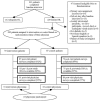Physician notification of their diabetes patients' limited health literacy. A randomized, controlled trial
- PMID: 16307624
- PMCID: PMC1490250
- DOI: 10.1111/j.1525-1497.2005.00189.x
Physician notification of their diabetes patients' limited health literacy. A randomized, controlled trial
Erratum in
-
Physician notification of their diabetes patients' limited health literacy: A randomized, controlled trial.J Gen Intern Med. 2005 Nov;20(11):1077. doi: 10.1111/j.1525-1497.2005.00309.x. J Gen Intern Med. 2005. PMID: 27519856 Free PMC article. No abstract available.
Abstract
Background: Many patients with chronic disease have limited health literacy (HL). Because physicians have difficulty identifying these patients, some experts recommend instituting screening programs in clinical settings. It is unclear if notifying physicians of patients' limited HL improves care processes or outcomes.
Objective: To determine whether notifying physicians of their patients' limited HL affects physician behavior, physician satisfaction, or patient self-efficacy.
Design: We screened all patients for limited HL and randomized physicians to be notified if their patients had limited HL skills.
Participants: Sixty-three primary care physicians affiliated with a public hospital and 182 diabetic patients with limited HL.
Measurements: After their visit, physicians reported their management strategies, satisfaction, perceived effectiveness, and attitudes toward HL screening. We also assessed patients' self-efficacy, feelings regarding HL screening's usefulness, and glycemic control.
Results: Intervention physicians were more likely than control physicians to use management strategies recommended for patients with limited HL (OR 3.2, P=.04). However, intervention physicians felt less satisfied with their visits (81% vs 93%, P=.01) and marginally less effective (38% vs 53%, P=.10). Intervention and control patients' post-visit self-efficacy scores were similar (12.6 vs 12.9, P=.6). Sixty-four percent of intervention physicians and 96% of patients felt HL screening was useful.
Conclusions: Physicians are responsive to receiving notification of their patients' limited HL, and patients support the potential utility of HL screening. However, instituting screening programs without specific training and/or system-wide support for physicians and patients is unlikely to be a powerful tool in improving diabetes outcomes.
Figures
Comment in
-
Weakness in numbers. The challenge of numeracy in health care.J Gen Intern Med. 2005 Nov;20(11):1071-2. doi: 10.1111/j.1525-1497.2005.051498.x. J Gen Intern Med. 2005. PMID: 16307637 Free PMC article. No abstract available.
Similar articles
-
Closing the loop: physician communication with diabetic patients who have low health literacy.Arch Intern Med. 2003 Jan 13;163(1):83-90. doi: 10.1001/archinte.163.1.83. Arch Intern Med. 2003. PMID: 12523921
-
The impact of health literacy on desire for participation in healthcare, medical visit communication, and patient reported outcomes among patients with hypertension.J Gen Intern Med. 2013 Nov;28(11):1469-76. doi: 10.1007/s11606-013-2466-5. Epub 2013 May 21. J Gen Intern Med. 2013. PMID: 23690237 Free PMC article. Clinical Trial.
-
Impact of communicative and critical health literacy on understanding of diabetes care and self-efficacy in diabetes management: a cross-sectional study of primary care in Japan.BMC Fam Pract. 2013 Mar 23;14:40. doi: 10.1186/1471-2296-14-40. BMC Fam Pract. 2013. PMID: 23522359 Free PMC article.
-
Diabetes self-management in patients with low health literacy: ordering findings from literature in a health literacy framework.Patient Educ Couns. 2012 Jul;88(1):44-53. doi: 10.1016/j.pec.2011.11.015. Epub 2011 Dec 24. Patient Educ Couns. 2012. PMID: 22196986 Review.
-
The role of health literacy in patient-physician communication.Fam Med. 2002 May;34(5):383-9. Fam Med. 2002. PMID: 12038721 Review.
Cited by
-
Primary care provider perceptions of the effectiveness of two self-management support programs for vulnerable patients with diabetes.J Diabetes Sci Technol. 2012 Jan 1;6(1):116-24. doi: 10.1177/193229681200600114. J Diabetes Sci Technol. 2012. PMID: 22401329 Free PMC article. Clinical Trial.
-
Nurse overestimation of patients' health literacy.J Health Commun. 2013;18 Suppl 1(Suppl 1):62-9. doi: 10.1080/10810730.2013.825670. J Health Commun. 2013. PMID: 24093346 Free PMC article. Clinical Trial.
-
Clinical implications of numeracy: theory and practice.Ann Behav Med. 2008 Jun;35(3):261-74. doi: 10.1007/s12160-008-9037-8. Epub 2008 Aug 2. Ann Behav Med. 2008. PMID: 18677452 Free PMC article. Review.
-
Pharmacy-Based Approach to Improving Heart Failure Medication Use by Older Adults with Limited Health Literacy: Learning from Interdisciplinary Experience.Drugs Aging. 2018 Nov;35(11):951-957. doi: 10.1007/s40266-018-0586-7. Drugs Aging. 2018. PMID: 30187287 Clinical Trial.
-
The METER: a brief, self-administered measure of health literacy.J Gen Intern Med. 2010 Jan;25(1):67-71. doi: 10.1007/s11606-009-1158-7. Epub 2009 Nov 3. J Gen Intern Med. 2010. PMID: 19885705 Free PMC article.
References
-
- Institute of Medicine., editor. Health Literacy: A Prescription to End Confusion. Washington, DC: National Academies Press; 2004. - PubMed
-
- Ad Hoc Committee on Health Literacy for the Council on Scientific Affairs AMA., editor. Health literacy report of the Council on Scientific Affairs. JAMA. 1999;281:552–7. - PubMed
-
- Williams MV, Parker RM, Baker DW, et al. Inadequate functional health literacy among patients at two public hospitals. JAMA. 1995;274:1677–82. - PubMed
-
- Gazmararian JA, Baker DW, Williams MV, et al. Health literacy among Medicare enrollees in a managed care organization. JAMA. 1999;281:545–51. - PubMed
-
- Berkman ND, DeWalt DA, Pignone MP, et al. Literacy and Health Outcomes. Rockville, MD: Agency for Healthcare Research and Quality; 2004.
Publication types
MeSH terms
Grants and funding
LinkOut - more resources
Full Text Sources
Medical

